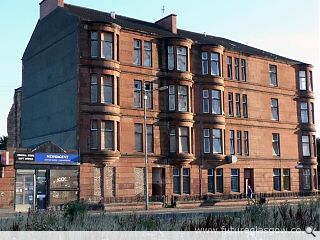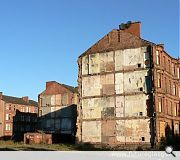Malcolm Fraser speaks out over Commonwealth Games demolitions
April 11 2011
Plans to level the last vestiges of pre-war tenement housing stock in Glasgow’s Dalmarnock district have elicited the ire of Malcolm Fraser. Writing in The Herald, Fraser acknowledges that the Commonwealth Games are a “thoroughly good thing” but challenges the short termism of their implementation, evoking echoes with the “institutionalised contempt” and “lacerating self harm” exhibited toward historic building stock in the bad old days. The full text proceeds below...Wrecks and the City
While Glasgow bobbies used to go about in pairs, it seems it needs 60 of them, together, to face the public these days.
On the 22nd of last month it took around that number (and a helicopter) to disperse the 15 students who had been occupying the vacant Hetherington Club in protest at Glasgow University’s extraordinary proposals to cut courses.
And it took 60 again (no news of the helicopter) a few days later to evict Margaret and Jack Jaconelli from the flat they owned and had lived in for over 30 years, in Ardenlea Street in Glasgow’s east end. We may worry about police cuts, but here is one “front line” which could lead the way to more efficient public services.
The eviction, with its heavy-handed police support, came on the back of a compulsory purchase order granted to Glasgow City Council to allow the demolition of a whole swathe of red sandstone tenements on Ardenlea Street, Sunnybank Street, Springfield Road and Summerfield Street in Dalmarnock, to make way for the athletes’ village for the 2014 Commonwealth Games. Demolition is imminent – it may even start next week.
Of course, the Commonwealth Games coming to Glasgow is a thoroughly good thing, and the opportunity taken to lever regeneration in Glasgow’s devastated east end laudable.
The plans by the public Clyde Gateway Urban Regeneration Company to turn the village, after the athletes leave, into a mix of social and owner-occupied housing,seem sensible. The new housing and masterplan, by architect RMJM, looks promising and may well be very good – a next step in Glasgow’s reinvention following the success of the New Gorbals. A compulsory purchase order may be an unpleasant last resort, but is it not justified, when it serves the greater good in such a way?
The demolition of sandstone tenements to lever “regeneration” is, of course, familiar to Glaswegians. Swing, hammer, swing. There are few great world cities – and Glasgow, even to this Edinburgh boy, is unquestionably one of our great achievements in urban living – that have treated their built fabric with such institutionalised contempt, and done such lacerating self-harm.
Chiefly to its working-class areas, of course. The west end’s couthy tenements – home, I suppose, to our 15 student protesters – remain intact, forming bustling and beautiful Glaswegian city quarters. It is areas like Dalmarnock that we levelled and built tower blocks on, sometimes then levelling the tower blocks in turn. The Jaconellis’ tenements edge a landscape as desolate as the surface of the moon, lonely reminders of the culture and building form that once brought life to this part of Glasgow.
So why couldn’t they have been spared and repaired? Or, more than spared, why couldn’t they have been regarded as forming a valuable part of a regenerated Dalmarnock, with the old mixed with the new, and RMJM’s vision of the lightness and openness of its modern homes set against the history, strength and beautiful craft and materiality of the red sandstone tenements?
They have been spared once before. It is almost exactly 40 years since the establishment of the Govan Housing Association marked the start of the fightback against the unthinking destruction that passed for regeneration in Glasgow in the 1960s. It is clear that the old stone tenements that were saved have outlasted the housing thrown up to replace those demolished – as they will outlast the housing we build now, for we plan now for decades, not the hundreds of years these buildings, loved and repaired, can last.
Our Dalmarnock tenements were, I’m told, repaired and modernised in the 1980s, as part of the GEAR – Glasgow Eastern Area Renewal – initiative that saved the remnants of the east end, and could have been repaired and renewed again, today.
I have searched for the reasoning behind their death sentence and can find little more than that architect RMJM considered them to be “boarded up and really depressing looking”. Well, of course, if we blight somewhere by condemning it and moving people out, it doesn’t tend to cheer the place up.
More interestingly, RMJM also says it “wants to get rid of the monolithic housing and create aspirational housing for young people”.
It is a vision of “regeneration” where neither the Jaconellis (who are grandparents) nor their sandstone tenements appear to be welcome. The irony is that it is exactly the sort of mobile young professionals, that such a vision yearns for, that in reality aspire to the nice tenements of Glasgow’s west end – while your average estate agent will tell you that it’s the Glasgow working classes that have fallen out of love with the tenement, and yearn for the suburbs.
It is a strange inversion, then, that leads us to knock down something most suited to those we advertise as our clientele. Put another way, what would have been truly “aspirational” here would have been that mixed old-new neighbourhood I’ve sketched out, rooted to its past but also looking forward, with its repaired and renewed tenements teasing the east end to fall in love with them again.
So, is this demolition symptomatic of Glasgow repeating the mistakes of the 1960s, demonising and demolishing the historic built environment? Is this the city returning to its bad old days? Certainly, walking round Glasgow today we see a distressing number of fine old buildings standing empty, with a lot of shiny new ones of often questionable quality going up beside them.
I was asked recently to come up with uses for an abandoned, beautiful old Victorian school (not in Glasgow but the principle stands). The school was abandoned because, as I was told: “The roof leaks and would have cost thousands to repair” – such an unthinkable prospect that they were moved to spend several tens of millions building a new school. I looked round the old building, at its abundant natural light, perfect urban location and beautiful, long-lasting sandstone (all virtues the new building lacked) and gave my verdict: it would make a great school.
Glasgow has many such examples, a significant one being Springburn College, its towering, 100-year-old red sandstone building abandoned for a towering new aluminium-panelled one directly across the road – by architect RMJM, again. The old building, by the significant Glasgow architect James Miller, is already a problem – boarded up and really depressing looking, with security guards patrolling it and the increasing likelihood that, if we don’t cobble together some use for it (it would make a great college) it will “go on fire”, or be condemned as not aspirational.
The problem is that the bad old days are still here. And the verdict on Glasgow must be that the problem is no worse here than elsewhere – over Scotland, over the world.
The central issue is that we are at our defining moment in human development, where we have rampaged our way through the world’s resources and reached a limit: peak oil, resource depletion, environmental degradation, climate change and banking and unending-credit collapse. The question for us all is how to make better use of our existing resources. In the built environment the primary resource is our existing stock of buildings, and our urgent need now is how to make best use of them.
Two pressing issues define the built environment’s problem, and lead the way out of it. The first is our fatally-skewed view of the issue of “sustainability”. We have let the word be redefined by the business community to suit its wish to keep on doing what it likes doing – which is continuous consumption and inbuilt-obscelescence. In the built environment this means a cycle of continuously knocking down buildings and starting again, or fixing expensive green gizmos to them.
Our Dalmarnock tenements have stood there for 100 years and could, with care and attention, stand there for hundreds more. They are, currently, expensive to heat. But with a bit of care and some modest investment their insulation and draught-proofing qualities can be hugely raised; and, in 40 years, when standards and technologies have raised and improved yet more, these sturdy monoliths can be simply renewed again.
We just don’t build like that any more. We have found it cheaper and easier to build more flimsy, short-lived buildings, that last for maybe 40 years. So, in 40 years time, when we might be doing a little extra work to further upgrade our tenements, we may also be demolishing wholesale the houses we were building in the 2010s – just as we are now demolishing many from the 1960s.
It makes no sense, this endless cycle of demolition and new-build, resource-consumption and landfill. Yet official advice continues to assert that, when we talk about sustainability in the built environment, step one is demolition and new-build. In any case the concentration on new-build is of marginal or even negligible importance to the fight against climate change. At the rate of replacement of our building stock before the banking and housing collapse – and remembering that the new buildings we build now are shorter-lived than those we knock down – it would take us 1300 years to renew our complete built environment. We will be deep under water by them. And post-banking and housing collapse, the 1300 years extends indefinitely.
If the fight against climate change is to be won, our shock troops are draught-stripping and loft insulation – a wee bit less glamorous, I admit, than the comprehensive regenerations and brave new visions of the big business community, but we are going to have to change our attitudes and get used to a world that is less glamorous and more homely.
The second pressing issue is that of tax. Our relationship with the historic built environment is defined by sentiment: National Trust teas, television costume dramas and wee Government grants towards stone repairs. We assume that our affection is matched by such gentle support for keeping old buildings.
But the reality is very different. The necessary repairs and improvements to our Dalmarnock tenements would attract 20% VAT. Their demolition is zero-rated, as is the construction of the new buildings that will replace them. This, in practice, represents massive Government support and encouragement for the endless cycles of landfill that are wrecking us.
I, and others, have fought for decades for a flat rate of VAT across construction. It would be the most extraordinarily effective little policy change the built environment has seen, for at a stroke, it would level the playing field, changing the way we build by shifting energy and attention into repair and renewal, where it needs to be.
Its secondary consequences would be major. First, repair and renewal is more labour-intensive than demolition and new-build, so vast numbers of jobs would be created. Second, Britain has hundreds of thousands of homes that are lying empty, because they need improvements that the high VAT rate renders uneconomic. The huge numbers of them that would be brought back into use would make joyful inroads into our national housing shortage.
It would also take the heat out of the sterile heritage-versus-development fight: campaigners for old buildings tend to have to rely on sentiment because the VAT burden makes their case uneconomic. Finally, it would reverse the hollowing-out of British cities, where town and city-centre buildings lie empty while volume house- builders fight to build car-dependent estates on green fields at their edges.
It is such a big, useful, regenerative, job-creating, homelessness-reducing, popular policy that the major parties should be fighting each other for it. Are they too stuck in their view that they can only do what big business lets them to remember that this is a democracy, and there are votes to be won?
It might be too late for Dalmarnock, but we are going to have to come to our senses sometime soon.
Malcolm Fraser

The tenements were previously repaired and renovated in the early 1980s as part of pioneering work by GEAR
|
8 Comments
#2 Posted by Clarion on 11 Apr 2011 at 16:25 PM
He's right of course... presumably you have read the whole thing?
http://www.heraldscotland.com/news/home-news/wrecks-and-the-city-1.1095500
A bigger man than "Big Malky" is, clearly.
http://www.heraldscotland.com/news/home-news/wrecks-and-the-city-1.1095500
A bigger man than "Big Malky" is, clearly.
#3 Posted by Mama Jinayshin on 12 Apr 2011 at 13:30 PM
This is another well written case in favour of improving Scotland's built environment, economy, and self esteem, argued with passion and humour.
The fact that rmjm come in for some relevant and justified criticism is just a delightful bonus.
The fact that rmjm come in for some relevant and justified criticism is just a delightful bonus.
#4 Posted by Tom McNamara on 14 Apr 2011 at 11:28 AM
The image for the Village on the RMJM home page looks pretty forgettable compared to the other projects featured in the slideshow.
#5 Posted by Auntie Nairn on 19 Apr 2011 at 14:22 PM
Reading the next article, the renovation of St Andrews House is made possible with a grant from the Business Premises Renovation Allowance Scheme. Why is there not an equivalent "Avoid demolition of the decent buildings in favour of cheap but fashionable shite Allowance Scheme". God, this country is so short fucking sighted
#6 Posted by jack jaconelli on 3 Aug 2011 at 17:56 PM
wee malky sounds like a little shite wait till they come banging on your door with a CPO see how brave you are you little shit.
#7 Posted by Uncle Stevie on 14 Dec 2013 at 23:21 PM
All of what malc says is true of course! But again who is granting these compulsory purchase orders and letting these old buildings mysteriously go on fire? It's no mystery, complete repeat of 60's, look at old gorbals! Was it not rmjm that built those hideous blocks that sit on the south side of the river in the 60s? The eastend is long overdue a facelift, it's just a shame it's a transplant rather than some Botox or minor surgery! Another historic piece of Glasgow destroyed! Who cares???
#8 Posted by ecclefechan on 27 May 2014 at 13:37 PM
It's not worth destroying a single building for a ridiculous colonial anachronism like the commonwealth games!
Post your comments
Read next: Mansell progresses St Andrew House strip out
Read previous: Glasgow hosts Games Legacy Summit
Back to April 2011
Like us on Facebook
Become a fan and share
News Archive
Search News
Features & Reports
For more information from the industry visit our Features & Reports section.





...........Yawn !